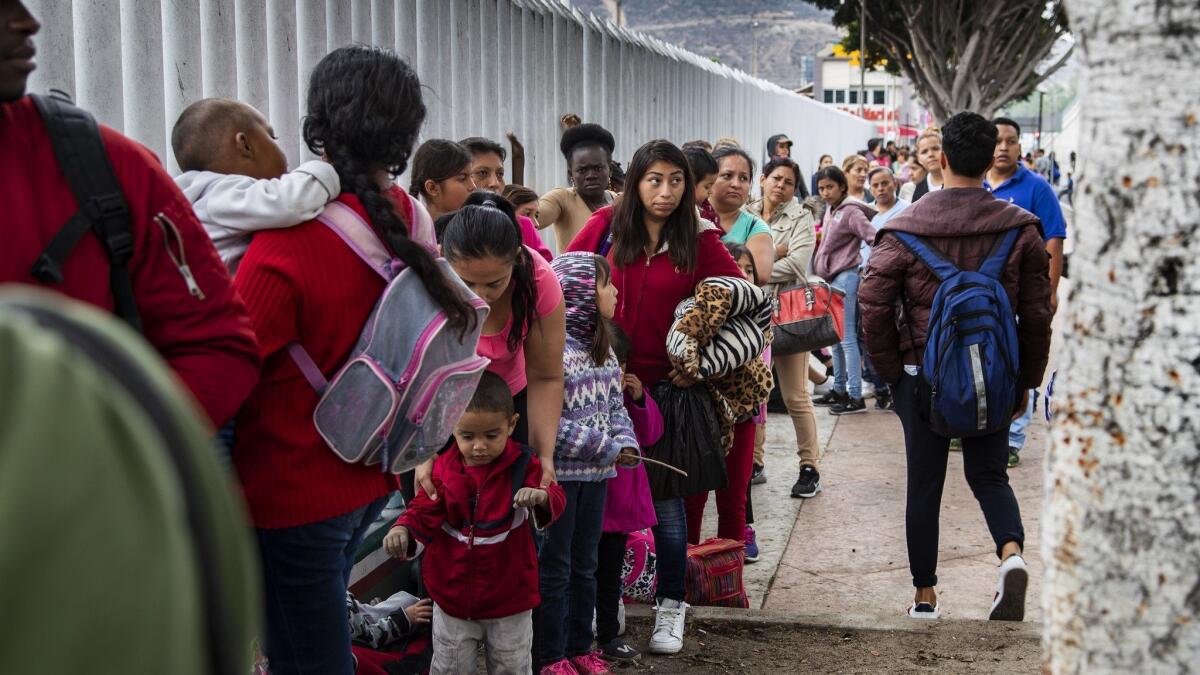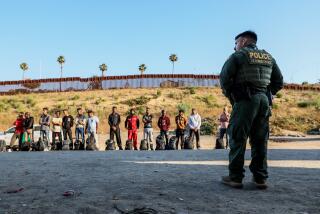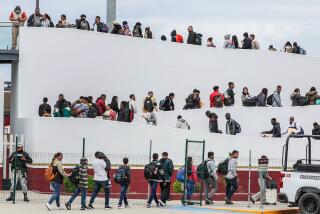The Trump administration says it’s a ‘myth’ that families that ask for asylum at ports of entry are separated. It happens frequently, records show

A woman named Mirian and her 18-month-old son reached Brownsville, Texas, early this year after fleeing Honduras, where the military had teargassed their home. She made her way to a port of entry and asked for asylum, according to court records.
Mirian had her identification, her son’s birth certificate, which listed her as his mother, his hospital birth record and his vaccination records.
Border officers took the records, then told her they would be taking her boy, she said in a sworn court declaration. They walked her out to a government car, told her to put him in a car seat and closed the door.
It was three months before they were reunited.
The Trump administration’s “zero-tolerance” policy of criminally charging people who cross the border illegally led to thousands of children being separated from their parents.
But the practice of separating families appears to have begun accelerating last year, long before zero tolerance was announced in the spring. Among these cases, according to records and interviews, are many that happened at ports of entry.
Administration officials have said repeatedly that asylum seekers who don’t want to be separated from their children should present themselves at a port of entry. Doing so is the legal way to ask for asylum, they said.
But court filings describe numerous cases in recent months in which families were separated after presenting themselves at a port of entry to ask for asylum.
This happened even when asylum seekers carried records, such as birth certificates or hospital documents, listing them as the parents of their children, according to interviews and court records.
While border officials have long had a policy of separating children when their safety might be in question, lawyers and advocates say they began seeing a significant increase last year in officials separating children from their parents who asked for asylum at ports of entry, without clear reasons.
In a ruling Tuesday ordering the reunification of families in a case brought by the ACLU, San Diego federal court Judge Dana M. Sabraw wrote that there had been a “casual, if not deliberate, separation of families that lawfully present at the port of entry, not just those who cross into the country illegally.”
Nicole Ramos, an attorney who provides legal help to asylum seekers in Tijuana, said she started to see an increase in family separations at ports of entry in May 2017.
Ramos has filed eight complaints related to this issue in recent months with the Department of Homeland Security’s Office for Civil Rights and Civil Liberties, which investigates civil rights violations.
Separations at ports of entry have happened “even when families have presented sufficient evidence of parentage, even where they do not have signs of neglect or abuse … even when the child is able to speak for themselves and say” this is my parent, Ramos said.
She said the problem has been compounded by long wait times at ports of entry. In some cases, families have been left waiting for weeks to claim asylum at a border crossing.
Lee Gelernt, the lead attorney on the ACLU’s case challenging family separations, said the government has justified taking children in some cases by saying there was concern a child was with a smuggler.
In one case, he said, “the little girl was screaming ‘Mommy, mommy, don’t let them take me away.’ Anyone would have known it was not a smuggler.”
In an email, U.S. Customs and Border Protection spokesman Daniel Hetlage referred a reporter to a Department of Homeland Security fact sheet, which says it is a “myth” that families asking for asylum legally at ports of entry are separated.
The sheet says DHS will separate in three circumstances: “1) when DHS is unable to determine the familial relationship, 2) when DHS determines that a child may be at risk with the parent or legal guardian, or 3) when the parent or legal guardian is referred for criminal prosecution.”
In a federal court declaration, Marc W. Sanders, acting director of Homeland Security’s Human Smuggling Cell, argued that releasing all families together can bolster human smuggling and increase illegal immigration.
“Once such a requirement is publicized it is likely to be a pull factor that contributes to further illicit migration to the United States,” he wrote.
Ramos said she worries that despite President Trump’s June 20 executive order to end family separations, border officials will continue separating families without due process by saying that a parent is a danger to the child or is not actually the parent.
“They were doing it before the zero-tolerance policy and they’re going to keep doing it,” she said. “They will say the parent presented a security risk without well-articulated reasons as to what that security risk was.”
It is unclear how often families have been separated at ports of entry.
Customs and Border Protection spokesman Carlos Diaz said the agency did not have data on such separations. But if a family asks for asylum at a port of entry, “it is highly likely that the family will stay together through the process,” Diaz added.
Diaz referred questions to the U.S. Citizenship and Immigration Service. Officials there referred a reporter back to Customs and Border Protection.
Officials at the Department of Health and Human Services, the agency in charge of children who are separated from their parents, said only that the total number of children in its care is 11,800. This includes children who crossed the border without parents as well as those separated from their parents.
The ACLU case that prompted Sabraw’s ruling described half a dozen cases of families separated at ports of entry, including Mirian’s.
In several of those cases, parents said in sworn declarations they had documents showing their relationship to their children and were never told that officials believed they were a danger to their children.
In one case, a man from Kyrgyzstan who sought asylum in October at the port of entry in San Ysidro, Calif., with his 13-year-old son was told a few days later that they would be separated.
“All I can remember is how much my son and I were both crying as they took him away,” the man wrote in a sworn declaration. “I do not recall anyone questioning whether I am really his biological father or whether I was a danger or abusive to him in any way. I even had my son’s birth certificate proving I am his father.”
In another case described in a lawsuit challenging family separations filed by 17 states and the District of Columbia, a mother who requested asylum at a port of entry in Laredo, Texas, with her 15-year-old son was told he would be taken to a shelter or “given to an American family for adoption.”
The child is an American citizen.
In May, a Guatemalan mother approached the San Ysidro port of entry with her three sons — ages 2, 6 and 13 — saying she feared returning to her country because of her husband’s community organizing work.
The family was taken to a detention center in Texas where they stayed together for two weeks before immigration officials took her children.
“Each minute that I am separated from my children is anguish,” the woman wrote in a court declaration.
In November, Jose Demar Fuentes arrived at the San Ysidro port of entry with his 15-month-old son, Mateo, having fled gangs in El Salvador.
He had Mateo’s original birth certificate, which listed him as the father, as well as his Salvadoran photo ID, said Olivia Caceres, Mateo’s mother.
Still, after Customs and Border Protection transferred Fuentes and his son to Immigration and Customs Enforcement officials, the boy was taken to a facility in Texas.
“They said he couldn’t prove he was the father, even though he had the original birth certificate,” Caceres said.
ICE officials said they were “unable to positively confirm a father/son relationship during the custody determination interview.”
When she learned what had happened to her son, Caceres said, “I felt like a bucket of cold water had been dropped on me.”
She said she does not understand why her partner and their son were separated.
“If they don’t want us to break the law and we come legally to ask for help and they’re still separating us from our kids — it’s hard,” she said.
Almost two weeks passed before Caceres learned that her son was in a facility. Eventually, after proving she was his mother, she was allowed five-minute video calls with him twice a week.
During the calls, Mateo would stare at her face or bring her toys, trying to pass them through the phone.
His only words to her, the only words he knows, were “ma” and “pa.”
Despite what happened with her son, Caceres in late December followed Fuentes’ lead and turned herself in at a port of entry to ask for asylum, along with her son Andree, who was 4 years old at the time.
She was released with an ankle monitor and allowed to remain with the boy.
In Los Angeles, with the help of family, Caceres worked to be reunited with Mateo.
At one point, she was asked to take a DNA test, but her lawyer successfully fought against it because documentation had already been provided that she was Mateo’s mother.
Finally, on Feb. 7, she got a call letting her know that Mateo would arrive at the airport the next day.
Eighty-five days had passed since Mateo was separated from his father.
“You tell yourself, the small children aren’t going to suffer, but they do,” Caceres said. “He was traumatized and is still traumatized.”
The first week, when visitors arrived at their home, the boy would grab his mother’s legs and cry if they came near him.
On a recent weekday morning, Mateo woke up screaming, like he often does since their reunion. His mother hugged him tight to her chest, rubbing his back and whispering to him in Spanish: “Aquí está mamá.”
“Mom is here.”
Twitter: @palomaesquivel
Twitter: @brittny_mejia
More to Read
Sign up for Essential California
The most important California stories and recommendations in your inbox every morning.
You may occasionally receive promotional content from the Los Angeles Times.












